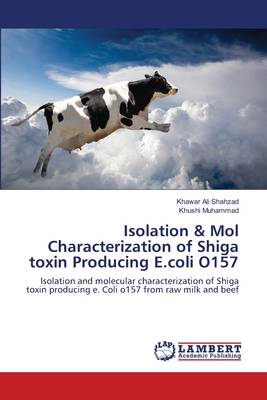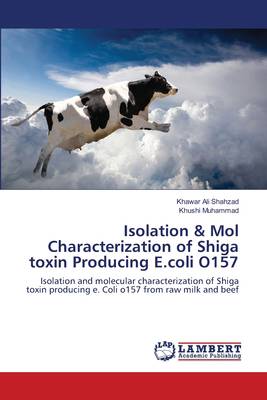
Bedankt voor het vertrouwen het afgelopen jaar! Om jou te bedanken bieden we GRATIS verzending (in België) aan op alles gedurende de hele maand januari.
- Afhalen na 1 uur in een winkel met voorraad
- In januari gratis thuislevering in België
- Ruim aanbod met 7 miljoen producten
Bedankt voor het vertrouwen het afgelopen jaar! Om jou te bedanken bieden we GRATIS verzending (in België) aan op alles gedurende de hele maand januari.
- Afhalen na 1 uur in een winkel met voorraad
- In januari gratis thuislevering in België
- Ruim aanbod met 7 miljoen producten
Zoeken
Isolation & Mol Characterization of Shiga toxin Producing E.coli O157
Isolation and molecular characterization of Shiga toxin producing e. Coli o157 from raw milk and beef
Khawar Ali Shahzad, Khushi Muhammad
Paperback | Engels
€ 57,95
+ 115 punten
Omschrijving
Escherichia coli is normal inhabitant of all the animals and human beings. Its non-sorbitol fermenting biotype (SNF) was detectable in buffalo (90 percent), cattle (80 percent) or rarely in sheep (20 percent) and goat (30 percent). However, SNF E. coli were un-detectable in droppings of rural chickens and feces of donkeys. The SNF E. coli was detected in 100, 92, 71 and 80 percent of the market milk samples and 100, 83, 83 and 53 percent beef samples from Multan, Sandha, Wagha and Sheikhupura Roads, of Lahore city, respectively. However, SNF E. coli was not detected from freshly aseptically collected milk and beef samples but was detectable in over all 96 percent of market raw milk and 82 percent market beef samples. White colored colonies of each positive sample on Sorbitol MacConkey s Agar (SMA) contained gram negative, rods with round ends non spore former. Each of the isolates was sorbitol non fermenter, lactose fermenter, indole positive, Methyl Red positive, Voges Prauskaur negative and citrate negative. However, each of such isolates showed green metallic sheen on Eosin Methylene Blue (EMB) agar. Each of the isolate was further characterized using polymerase chain reaction
Specificaties
Betrokkenen
- Auteur(s):
- Uitgeverij:
Inhoud
- Aantal bladzijden:
- 88
- Taal:
- Engels
Eigenschappen
- Productcode (EAN):
- 9783659203954
- Verschijningsdatum:
- 2/08/2012
- Uitvoering:
- Paperback
- Afmetingen:
- 152 mm x 229 mm
- Gewicht:
- 141 g

Alleen bij Standaard Boekhandel
+ 115 punten op je klantenkaart van Standaard Boekhandel
Beoordelingen
We publiceren alleen reviews die voldoen aan de voorwaarden voor reviews. Bekijk onze voorwaarden voor reviews.









